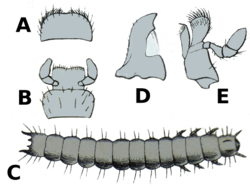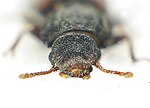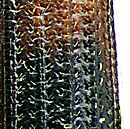Black and red bark beetle
| Black and red bark beetle | ||||||||||||
|---|---|---|---|---|---|---|---|---|---|---|---|---|

Black and red bark beetle ( Bitoma crenata ) |
||||||||||||
| Systematics | ||||||||||||
|
||||||||||||
| Scientific name | ||||||||||||
| Bitoma crenata | ||||||||||||
| ( Fabricius , 1775) |

A upper lip B lower lip with lip probe
C larva D upper jaw E lower jaw with jaw probe
The black and red bark beetle , also called keeled bark beetle ( Bitoma crenata ), is a beetle from the family of bark beetles and the subfamily Colydiinae . In the German-language specialist literature, the scientific name of the species was long Ditoma crenata .
In the old and new generic names Ditoma and Bitoma there is the word root tom-, which is in oldgr. τομή, tomē "cut" is included. It is supplemented by di- or bi-, which is based on Altgr. or Lat. "Two" means. The name alludes to the two-part antennae . The species name crenata (Latin crenātus, a, um, ) means "notched" and refers to the longitudinal keels of the wing coverts , between which the wing coverts appear notched. "Black-red" alludes to the color of the wing covers, "Bark beetles" to the habitat in which the species and related species can be found.
In Europe, the black and red bark beetle is the only representative of the genus Bitoma .
Characteristics of the beetle
The body shape of the beetle is adapted to its habitat under tree bark. The beetles, on average only 3 millimeters long, are flat and about three times as long as they are wide.
The head is wider than it is long and, with the exception of the reddish front edge, is matt black. The mouthparts are not visible from above. The upper jaws (Fig. 7 D) have a grinding surface that extends far inwards at the base, above they are strongly bulged on the inside, the bulge is covered with a skin seam. They end in a two-pronged point. The upper lip is slightly rounded and ciliate in front (Fig. 7 A). The four-part jaw probes are short, the end part widens conically and is truncated at an angle (Fig. 7 E). The end link of the three-part lip stylus is slightly narrowed towards the front and trimmed straight (Fig. 7 B).
The feelers (Fig. 2) have eleven sections. They are turned in under the edge of the forehead in front of the eyes. The last two links form a club. The two base members are slightly larger, the remaining seven members form a scourge that becomes slightly thicker towards the outside. The eyes are round and arched.
The roughly square pronotum (Fig. 1) is matt black and pulled forward at the front corners. The disc is slightly indented and set off against the side with an edge that is slightly bent outwards. Between this edge and the side edge there is a distinct keel on both sides over the entire length of the pronotum.
The elytra are in rare cases completely red, but usually black along the suture of the wing cover and on a wide transverse band. Together they are about twice as long as they are wide, and the same width as the pronotum. Their outer edges are parallel to each other. They have rows of dots that are wider than the spaces between two rows of dots lying next to each other. The row of skutellar dots next to the label is only short. The wing cover seam and every other space between the rows of dots is raised like a keel (Fig. 6). The label is wider than it is long and tiny.
The underside is matt black (Fig. 5). Five abdomen segments are visible. The red-brown legs are strongly turned outwards. Front and middle hips are spherical and hardly protrude from the chest. The thighs are only slightly thickened in the shape of a club, the rails are straight, widen slightly towards the outside and are finely thorn at the end. The tarsi are all four-limbed, the first three tarsi short and about the same length, together they are shorter than the claw limb. The claws are kinked and pointed.
biology
The beetles live and develop under dead, loosening tree bark from deciduous and coniferous trees and under dry tree sponges . Larva (Fig. 7 C) and imago live predatory on small arthropods. According to Reitter , the larva "lives under the beech bark in the tunnels of the bark beetle Taphrorychus bicolor , whose larvae and nymphs it consumes". The adults are often to be found sociable all year round, occasionally in the sun on the bark.
distribution
The species is found in almost all of Europe and the Middle East .
literature
- Heinz joy, Karl Wilhelm Harde, Gustav Adolf Lohse (ed.): The beetles of Central Europe . tape 7 . Clavicornia. Spektrum Akademischer Verlag, Munich 1967, ISBN 3-8274-0681-1 .
- Gustav Jäger (Ed.): CG Calwer’s Käferbuch . K. Thienemanns, Stuttgart 1876, 3rd edition
- John Curtis British Entomology Vol. 6 No. 283 as a Google e-Book
- Wilhelm Ferdinand Erichson Natural history of Germany's insects: Coleoptera 1884 p. 265 ff as Google eBook
Individual evidence
- ↑ a b Bitoma crenata in Fauna Europaea. Retrieved October 24, 2011
- ↑ Gustav Adolf Lohse, Wilhelm H. Lucht: Die Käfer Mitteleuropas . tape 13 , 2nd supplement volume with catalog section. Goecke & Evers, Krefeld 1992, ISBN 3-87263-043-1 .
- ↑ Sigmund Schenkling: Explanation of the scientific beetle names.
- ↑ Edm.Reitter: Fauna Germanica, the beetles of the German Empire III. Volume, KGLutz 'Verlag, Stuttgart 1911 p. 115





